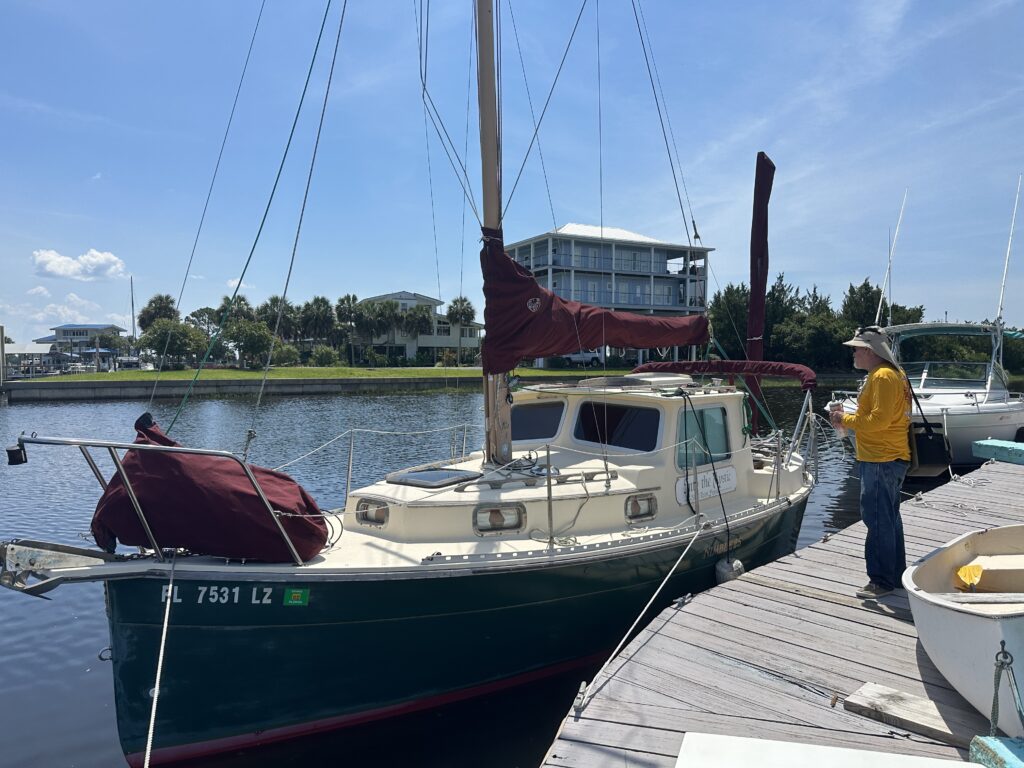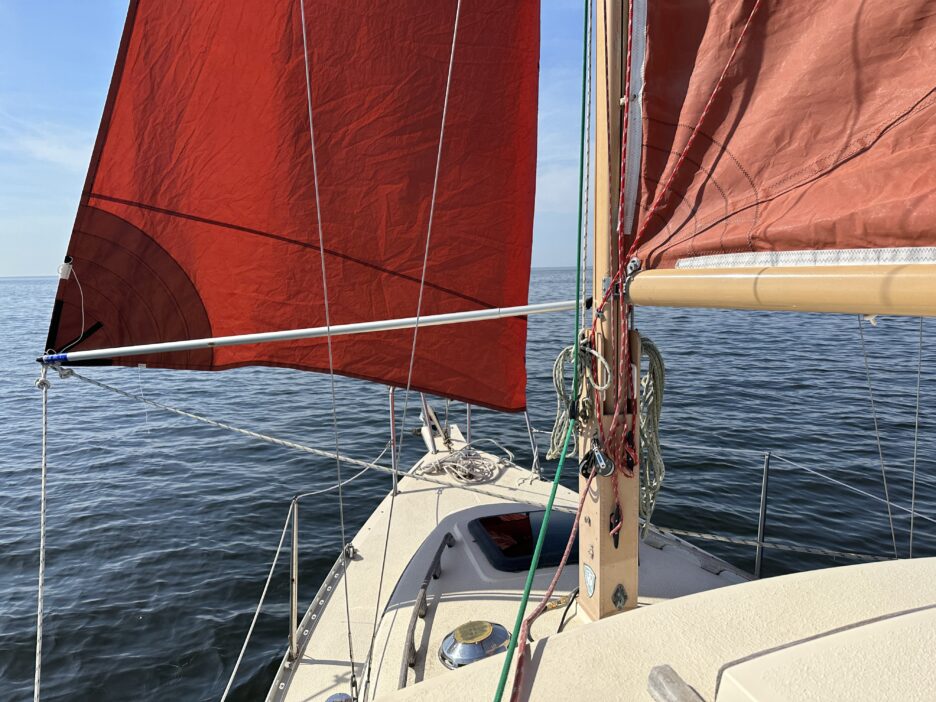As most of the U.S. now knows, Hurricane Idalia ripped through Florida at the tail end of August 2023. I was living within the cone of the storm’s landfall (which happened on August 30th) right up until its last hours in the Gulf of Mexico. In a very short window, I learned a lot about the decisions you have to make as a boat owner. Fortunately, I made the right ones.
Humble beginnings for a monster storm
Idalia didn’t project itself as the monster storm it would become–a Cat 4 hurricane–when it started out as a tropical depression off of Mexico. But when Ted, a friend of mine and long-time boat owner, texted me and asked if I was watching “the storm,” I immediately knew I should start paying attention.
At the time, I wasn’t too worried. I was dimly aware of its presence, but Mexico seemed a long way from Shell Point and Apalachee Bay. I didn’t think I needed to make an immediate decision on what to do with Isabella, my Nimble Arctic 25 sailboat (which, incedently, I had purchased from Ted).

One week after I bought my Nimble Arctic 25, I was faced with a decision about what to do as a tropical storm bore down on Apalachee Bay and Shell Point.
Fortunately, Ted and I were going to see each other at a social event at the Apalachee Bay Yacht Club later that evening. I would pick his brain. In the meantime, I started doing a little cruising on various weather channels.
The storm seemed pretty far away. But when I saw Ted, he said we needed a “go / no go” decision in 36 hours, three days before the projected landfall. Otherwise, we would be stuck with Isabella in the water when the storm hit. As the owner and captain, the decision was mine.
Ted wasn’t judgmental. As a new boat owner, he just wanted me to make sure I understood this was a serious decision with significant implications.
His instincts were right. I thought I had time. I really didn’t.
Deciding to pull Isabella from the water
The following day, Sunday, I spent some time reading up on the storm. It was still unnamed and we were 48 hours away from the storm becoming a hurricane. But the tone of the reporting made it clear that this tropical depression would become a tropical storm and, ultimately, a hurricane. And the storm would pick up speed and power fast.

Idalia was a mere tropical storm on Monday at 7 am when I had to make a decision about whether to pull Isabella.
All the meteorological factors existed to make it a hurricane, perhaps even a major one. Moreover, the “cone” surrounding the predicted path of the center was narrow. This indicated that even though different forecasting models predicted different paths, the general area where the storm would make landfall was pretty clear.
Guess what? Apalachee Bay was right in the cross hairs. Moreover, Shell Point would be inside the cone and, in all likelihood, inside the eye wall if it became a hurricane.
I made the decision to pull Isabella from her slip and take her home to Tallahassee Sunday night. When Ted texted me on Monday morning at 8 am about “the plan,” I was already making the near hour-long trip to Shell Point. I would arrive at 8:30 am. As I saw more and more boats on trailers heading north, I soon wished I had planned to arrive at the dock an hour earlier at daybreak.
The decision to pull Isabella out of the water should have been a no-brainer. But I am new to boat owning and this decision was my most consequential one.
I had owned the boat for just one week, and I hadn’t even gone out on a solo cruise. Isabella is still very new to me.
Fortunately, getting the boat ready to sail to the boat ramp didn’t take a lot. I just needed to start the motor, cast off the lines, and navigate the channel to the canal that lead to the ramp. The trip would maybe take 15 minutes.
But, as this was my first time going to the boat ramp, and the first time in the channel not going to ABYC, I got lost and went up the wrong canal! Figuring out how to manage the outboard motor, turn around a 25′ (at waterline) sailboat with an extended bowsprit and aft rigged mizzen was a little more daunting in a narrow channel. The Nimble was built for cruising so it does not turn on a dime. It took me about 15 minutes to get back on track in the right direction and in the right canal.
But I made it to the boat ramp, and Ted was waiting there, pacing.
The dangers of delayed decisionmaking
The problem with pulling a boat before a storm is not the actual process of pulling the boat. Although I had not driven a trailer in 30 years, I knew the basic principles and mechanics of pulling it. Rather, and the reason why Ted was nervous, was that everyone else would be pulling their boat in anticipation of the storm, too.
Boat ramps can get crowded. As the storm gets closer, the rush would be even greater. Delays would be greater, the tendency to rush the process would increase, and the potential for consequential errors would much higher.
Moreover, and something as an inexperienced sailor I did not even think about, boats ramps will close as storms get closer. This makes sense in retrospect. A traffic jam at a boat ramp can be deadly and dramatically increase the risks of property damage.
Unlike most motor boats, we would also have to lower the mast to make it trailerable, remove the boom (which controls the mainsail), stow the sails, lower the stays and shrouds (the wires holding the mast(s) up), and remove the mizzen mast. I had never done any of this. Fortunately, Ted, as the previous owner, had done this before and created nifty gadgets to make it easier. We still took more than an hour to get Isabella ready to head north.
The next problem I faced was where to put Isabella! Buying the boat was a flurry of decisions and activities as I tried to get everything taken care of before the semester started at Florida State University on–August 28th (the day I ended up pulling her from the water). I had hoped I might have a few weeks (or months) to breath before learning to do complicated things like prepare a 25 foot sailboat to trailer it an hour north to Tallahassee!

Isabella sits in my driveway after she was pulled from Apalachee Bay and readied for trailering
Mother nature had different plans, apparently. Fortunately, although Isabella would be exposed, I was able to pull her into a relatively safe spot in my driveway. She is a heavy boat, but I still worried about winds strong enough to topple her over on the trailer.
I didn’t need to worry. She handled the wind gusts–55+ mph–without hardly noticing. In fact, if she were a human, I would say she pretty much slept through the storm. She would have easily handled hurricane force winds.
Turns out, my driveway ended up being a near perfect place for Isabella to wait out the storm.
Isabella does more than hold her own against 55+mph wind gusts. She benefits from being a sturdy cruiser.
Takeaways and lessons learned
So, what are my take aways as a sailboat owner from my Hurricane Idalia experience? I have five.
First, nature is going to do what it’s going to do. All we can do is manage, and hopefully mitigate, the risks to life and property. Property can be replaced.
Second, listen to those with more experience with storms and your boat. I was fortunate in that Ted had a great deal of experience, and he knew the Nimble Arctic well. I am sure he would have pulled the boat sooner, but I made the decision in time.
Third, decisive decisionmaking is paramount. If you are even thinking about pulling your boat from the water in front of a storm, do it. Pulling your boat reduces the chances of damage but it also gives you more peace of mind. In my case, I was able to watch Isabella from my front window.
Too much can happen to the boat and with the storm if you delay. Pulling a boat from the water can never be a last minute decision. It takes planning and execution.
Have doubts? Check out these videos showing the aftermath Idalia in Steinhatchee, Florida here and here.
Fourth, bring someone along to help. Comparing notes, discussing ideas, and seeking advice can all make the process smoother and more manageable.
Fifth, remember that every experience gives your knowledge and insight that will make the next time–which is inevitable–easier. Be patient with yourself, but don’t let that get in the way of making a decision. You will make mistakes, but that knowledge base becomes a platform for better future decision making.
Hurricane Idalia sped up what was already a steep learning curve more than I was comfortable. But these decisions had to be made. Fortunately, the end result is a boat that is ready to be back in the water doing what it does best–protecting my mental health.
